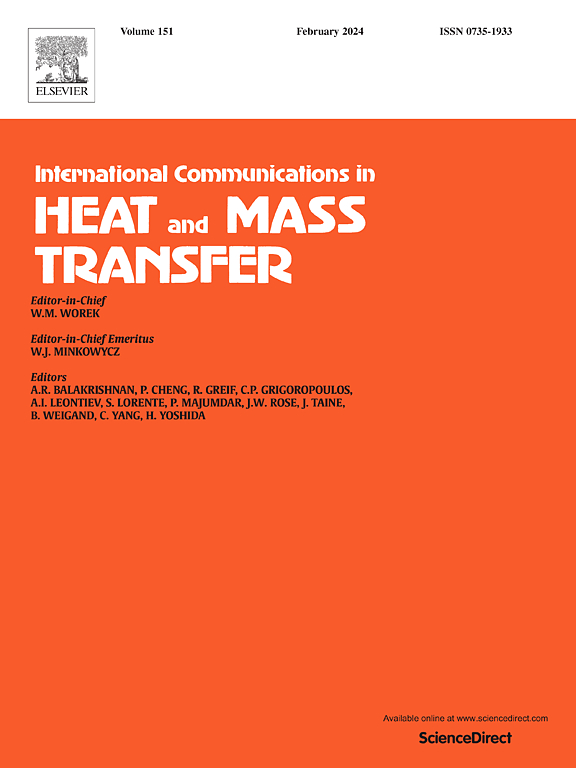Investigation and optimization of Shell-and-tube thermal energy storage unit with biomimetic leaf-vein fins and carbon nanotubes for superior PCM efficiency
IF 6.4
2区 工程技术
Q1 MECHANICS
International Communications in Heat and Mass Transfer
Pub Date : 2025-06-28
DOI:10.1016/j.icheatmasstransfer.2025.109250
引用次数: 0
Abstract
This study investigates the performance of a PCM (Phase Change Material) shell-and-tube heat exchanger enhanced with leaf vein-inspired fins and multi-walled carbon nanotubes (MWCNTs). Given the increasing demand for efficient thermal energy storage (TES) systems, which are often limited by slow thermal response and low thermal conductivity, we explore the integration of these design innovations to enhance heat transfer rates. The analysis compares four configurations without MWCNTs and four with MWCNTs, varying in fin thickness and angles. Key performance metrics, including temperature distribution, liquid fraction, and natural convection phenomena, velocity contours, sensible and total heat storage, and mean heat storage rates, were evaluated. The geometrical parameters (Length, width and Angle) of the storage unit are optimized utilizing the Box-Behnken designs (BBD) with response surface method (RSM). The significance of geometric parameters namely fins length, fin width and fin angle on the heat release time of Latent Heat Thermal Energy Storage (LHTES) are scrutinized, and corresponding quadratic equation is fitted. The function of the optimized target variable melting time on each factor is fitted and it is noted that with increasing the fins length and width of angle has a significant impact on the optimized target (melting time). Findings reveal that Case 03 with MWCNTs, featuring the thickest fins, achieves the shortest melting time of 1040 s, reflecting a time-saving of 58.06 %. This case also exhibits the highest mean heat storage rate of 437.903 W, representing a 123 % increase compared to the base case without fins or MWCNTs. Additionally, Case 01 with MWCNTs shows the highest sensible heat storage of 61.46 KJ and total heat storage of 490.9 KJ, whereas Case 01 without MWCNTs has total heat storage of 490.11 KJ. The inclusion of MWCNTs consistently enhances heat storage rates across all configurations, demonstrating the potential of optimized fin design and MWCNT integration to improve the thermal performance of PCM-based heat exchangers.
基于仿生叶脉翅和碳纳米管的壳管式储热装置的研究与优化
本研究研究了一种由叶脉启发翅片和多壁碳纳米管(MWCNTs)增强的相变材料壳管换热器的性能。鉴于对高效热能储存(TES)系统的需求不断增加,这些系统通常受到慢热响应和低导热率的限制,我们探索了这些设计创新的集成,以提高传热率。该分析比较了四种不含MWCNTs和四种含MWCNTs的配置,不同的鳍片厚度和角度。评估了关键性能指标,包括温度分布、液体分数、自然对流现象、速度轮廓、感热和总蓄热以及平均蓄热率。存储单元的几何参数(长度、宽度和角度)利用响应面法(RSM)优化Box-Behnken设计(BBD)。考察了潜热蓄热器的翅长、翅宽、翅角等几何参数对其放热时间的影响,并拟合了相应的二次方程。拟合了优化目标变量熔化时间对各因素的函数,发现随着翅片长度和角度宽度的增加,优化目标(熔化时间)的影响显著。结果表明,采用最厚翅片的MWCNTs的Case 03的熔化时间最短,为1040 s,节省了58.06%的时间。这种情况也显示出最高的平均储热率,为437.903 W,与没有翅片或MWCNTs的基本情况相比,增加了123%。此外,添加MWCNTs的Case 01的显热存储量最高,为61.46 KJ,总热存储量为490.9 KJ,而未添加MWCNTs的Case 01的总热存储量为490.11 KJ。MWCNT的加入在所有配置中都能持续提高储热率,这表明优化翅片设计和MWCNT集成在改善基于pcm的换热器热性能方面的潜力。
本文章由计算机程序翻译,如有差异,请以英文原文为准。
求助全文
约1分钟内获得全文
求助全文
来源期刊
CiteScore
11.00
自引率
10.00%
发文量
648
审稿时长
32 days
期刊介绍:
International Communications in Heat and Mass Transfer serves as a world forum for the rapid dissemination of new ideas, new measurement techniques, preliminary findings of ongoing investigations, discussions, and criticisms in the field of heat and mass transfer. Two types of manuscript will be considered for publication: communications (short reports of new work or discussions of work which has already been published) and summaries (abstracts of reports, theses or manuscripts which are too long for publication in full). Together with its companion publication, International Journal of Heat and Mass Transfer, with which it shares the same Board of Editors, this journal is read by research workers and engineers throughout the world.

 求助内容:
求助内容: 应助结果提醒方式:
应助结果提醒方式:


